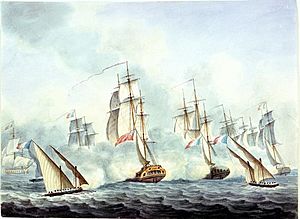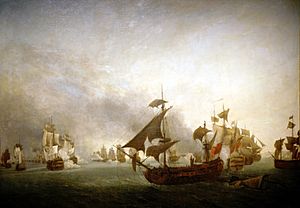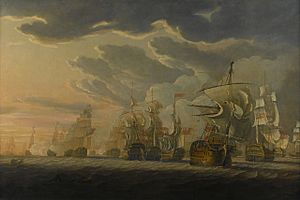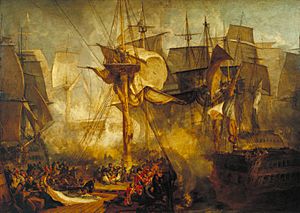William Prowse facts for kids
Quick facts for kids
William Prowse
|
|
|---|---|
| Born | 1752 |
| Died | 23 March 1826 St Pancras, London |
| Allegiance | United Kingdom of Great Britain and Ireland |
| Service/ |
Royal Navy |
| Years of service | 1771 – 1826 |
| Rank | Rear-Admiral |
| Commands held | HMS Raven HMS Salvador del Mundo HMS Prince of Wales HMS Sirius HMS Theseus |
| Battles/wars | Battle of Grenada Battle of Martinique Glorious First of June Battle of Cape St Vincent Battle of Cape Finisterre Battle of Trafalgar |
| Awards | Companion of the Order of the Bath |
William Prowse (1752 – 23 March 1826) was a brave officer in the Royal Navy. He served during the American War of Independence, the French Revolutionary Wars, and the Napoleonic Wars.
Prowse started his naval career from very humble beginnings as an able seaman. He had an exciting and busy career. He served under some of the most famous naval leaders of his time. He also took part in many important battles. These included the Battle of Grenada, the Battle of Martinique, and the Glorious First of June. He commanded ships at the Battle of Cape St Vincent, the Battle of Cape Finisterre, and the famous Battle of Trafalgar. He ended his career as a Rear-Admiral.
Contents
William Prowse was born in 1752. Not much is known about his childhood. He likely came from a working-class family in Devon, England. He probably started his sea career on merchant ships.
Prowse officially joined the Royal Navy on November 13, 1771. He started as an able seaman on the 74-gun ship HMS Dublin. He stayed on this ship for four years.
First Battles and Promotions
In November 1776, Prowse joined another 74-gun ship, HMS Albion. On August 31, 1778, he was promoted to midshipman and master's mate. The Albion was serving in North America at this time.
Prowse saw his first major battles while on the Albion. He fought in the Battle of Grenada on July 6, 1779. He also took part in the Battle of Martinique on April 17, 1780. During one of the fights at Martinique, Prowse was injured. A large piece of wood hit his head.
The Albion finished its service in December 1781. Prowse then passed his test to become a lieutenant in January 1782. By December 1782, he was a commissioned officer. He was assigned to the 90-gun ship HMS Atlas. He later moved to the 28-gun ship HMS Cyclops. Prowse continued to serve off North America until March 1784.
He left the navy for a few years, possibly working on merchant ships. He returned briefly in 1787 when there were problems with the Netherlands. He served on the 74-gun HMS Bellona. He left again when the problems passed. In 1790, he returned to the navy. He served on HMS Barfleur and then HMS Stately. From 1791 to 1793, he was on HMS Duke at Portsmouth.
Fighting in the French Revolutionary and Napoleonic Wars
War with France began in February 1793. On March 20, 1793, Prowse was assigned to the 90-gun ship HMS Prince. He later moved to HMS Barfleur as the sixth lieutenant.
The Barfleur was part of Lord Howe's fleet. Prowse was present at the Glorious First of June battle. During this battle, he was wounded in the leg. A cannon shot hit the gun he was aiming, and part of his thigh was torn. He had to leave the ship to recover.
Returning to Service
Prowse recovered quickly and returned to duty. He became the first lieutenant on the 74-gun HMS Theseus. They sailed to the West Indies and fought some small battles. They returned to Britain in July 1795.
Prowse then transferred to the 32-gun ship HMS Lively. They sailed to the Mediterranean Sea. On October 20, 1796, Prowse received his first independent command. He was given charge of the 14-gun sloop HMS Raven.
Battle of Cape St Vincent
The Raven was with the fleet at the Battle of Cape St Vincent on February 14, 1797. Prowse's ship was used to relay signals during the battle. The Raven also chased the large Spanish ship Santísima Trinidad but lost her.
For his good service, Prowse was promoted to post-captain on March 6, 1797. He was given command of a captured Spanish ship, the Salvador del Mundo. He took his ship back to Britain.
After a period on half-pay (meaning he wasn't actively serving), Prowse returned to duty. He became the flag-captain for Rear-Admiral Sir Robert Calder on his ship, HMS Prince of Wales. He served briefly in the West Indies. He returned to Britain in 1802 when the war paused.
In August 1802, Prowse was given command of the 36-gun frigate HMS Sirius. He helped blockade the French and Spanish coasts. When the war started again in May 1803, the Sirius was sent to the English Channel and the Bay of Biscay.
Battle of Cape Finisterre
In 1805, Prowse and the Sirius were scouting for the enemy fleet off Cape Finisterre. On July 22, Prowse found the combined French and Spanish fleet. He tried to capture a French frigate. However, the entire enemy fleet turned around and headed straight for him.
Prowse's small frigate was no match for the huge fleet. He quickly tried to get away. The Spanish admiral ordered his ships not to fire on the Sirius. However, some Spanish ships did fire, and two of Prowse's men were killed. After the battle, Prowse took a captured Spanish ship back to Plymouth.
Prowse's Role at Trafalgar
The enemy fleet sailed into Cádiz on August 21, 1805. The Sirius was sent to join the British fleet blockading them. Nelson arrived to take command. The British fleet stayed out at sea, but a line of frigates watched Cadiz. The Sirius was the closest to the port.
On October 19, Prowse saw the enemy preparing to leave port. He immediately signaled the next frigate, HMS Euryalus, "Enemy have their topsails hoisted." This was the start of the signals that led to the famous Battle of Trafalgar two days later. An hour later, Prowse signaled, "Enemy ships are coming out of port or getting under sail." This signal reached Nelson 48 miles away.
The next morning, October 20, Prowse investigated a strange ship. While doing so, a French warship fired at him. Prowse found the ship was a neutral American merchant and let it go. The entire enemy fleet finally left port by 10 a.m.
On October 21, Nelson called Prowse and three other frigate captains to his flagship, HMS Victory. They received their orders for the battle. Their job was to stay near the Victory and repeat Nelson's signals to the rest of the fleet. They also had to watch the battle, report on escaping ships, and help damaged British ships or captured enemy ships. They then witnessed Nelson's will. Prowse said goodbye to his nephew, Captain Charles Adair, who was on the Victory.
During the battle, the Sirius stayed out of the main fighting. No one on board was hurt. After the battle, the Sirius helped tow the damaged Victory. Prowse was later sent to Cadiz with a message from Admiral Collingwood about Spanish prisoners.
Later Years and Retirement
Prowse remained on the Sirius in the Mediterranean Sea. On April 17, 1806, he fought an enemy group of ships off Civitavecchia. His ship, the Sirius, forced the 18-gun Bergère to surrender. For this action, Prowse was praised and received a sword.

The Sirius finished its service in May 1808. In March 1810, Prowse took command of the 74-gun HMS Theseus. He commanded her in the North Sea until December 1813. After this, he no longer served actively at sea.
On June 4, 1815, he was made a Companion of the Bath. This was a special award for his service. He was promoted to Rear-Admiral on July 19, 1821. William Prowse died on March 23, 1826, in St Pancras, London, at the age of 72.




